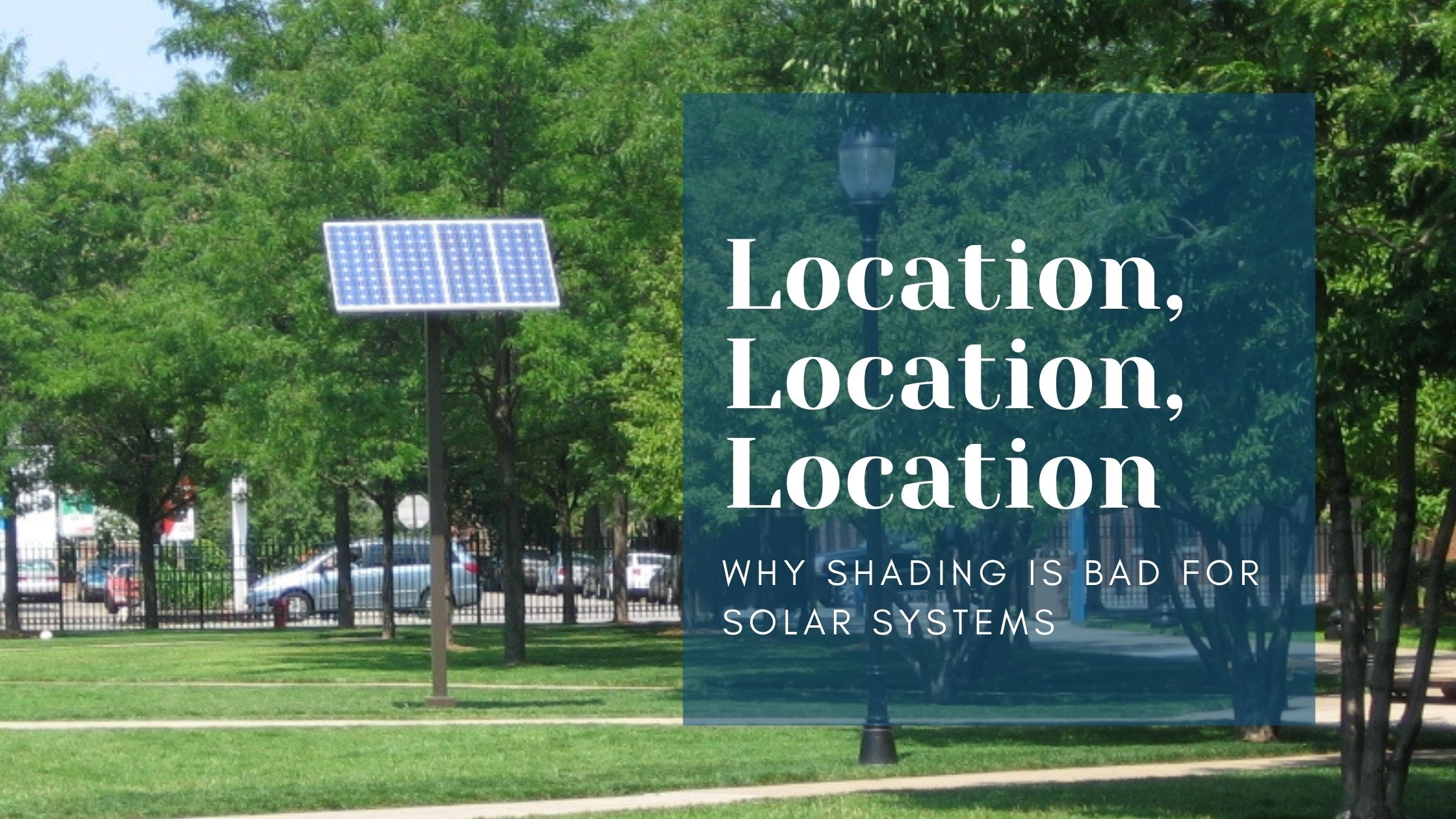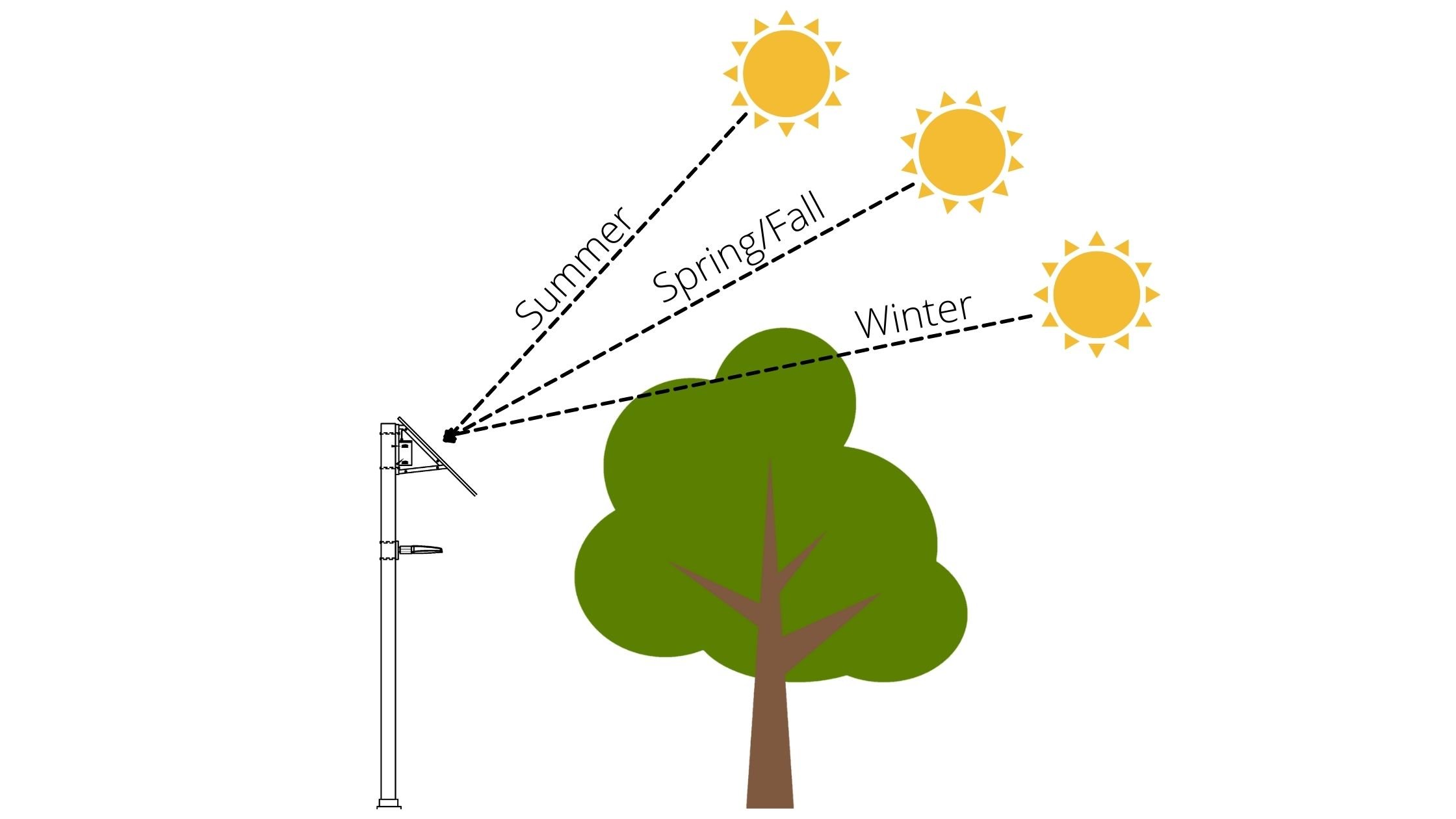


Shade is a wonderful thing, especially in the summer down here in the south; however, it is bad for off-grid solar power and solar lighting applications. This is because shading robs the solar panels of their peak energy production capacity, which in turn, has an adverse effect on overall system performance. Basically stated, if the solar is shaded, power will not be produced as expected, not allowing the batteries to fully charge, and causing system failures over time. Instead, make sure your installation location has full sun exposure.
Solar relies on the sun. Without it, it cannot produce energy. Whether you have a system that is installed on your roof to feed the grid or an off-grid system like ours for lighting or power applications, shade can affect the production of the system.
Off-grid units rely much more upon the sun than grid-tied units. A little shade doesn’t have as much effect on a grid-tied system since it can probably make up some of the differences during the day. However, an off-grid solar power or lighting system will have major problems if full exposure to the sun is not available.
Therefore, when scouting installation locations for off-grid solar-powered lights and/or solar power systems, the key is to find an area that has no shading between 9 am and 3 pm year-round. This allows it to gather as much solar energy as possible, ensuring the proper operation of the designed system. Since sun hours vary from one location to the next, system sizing is important to the design and operation of the unit. Any shade can greatly affect this performance.
If the needed light or powered application is in the shade, the solar can be remotely installed and the device can be located where it is needed. This allows the powered unit or light fixture to be mounted in the shade while allowing the solar to be placed in a sunny location. This is common practice with commercial-grade systems since there is the ability to customize the system to the needs of the project.

Shading issues are not always immediately apparent given the sun’s path during different times of the year. Shade from trees, poles, buildings, and many other obstructions can seriously diminish the performance of solar systems. Summer months have the sun at the highest point in the sky. However, in the winter months, the sun is lower, and if not considered during installation, the sun path can cause shading issues.
Trees can cause the worst kind of shade. It may not be as apparent when you are first installing, especially on a new site installation, but as trees grow, or during different times of the year, the trees can cause a lot of problems. Continuous observation will ensure that your system is performing at its peak; however, trimming or removal may be required to ensure there is plenty of sun in the winter months.
These are not as obvious obstacles to look out for, but power lines and poles can cause a lot of shading concerns, depending on their placement to the solar panels. Making sure that the installation location isn’t directly underneath the power lines or with a large power pole to the south of the solar is best when looking for a good place to put the system.
Large buildings that are on the east, west, or south of a solar panel and are taller than the panel installation can also cause a lot of issues with the shading of the panels. These are commonly overlooked when a solar solution is being introduced. This is especially true when customers are looking for a solution in the summer months when it doesn’t seem very clear that the buildings are going to cause an issue.
If the desired installation location is hampered by shading issues, note that the solar power system can be remotely located in a non-shaded area and simply wired to the power or lighting application. If trees are presenting a shading issue, in many cases simply trimming the trees back will eliminate the problem altogether. If buildings are what is blocking the solar from receiving full sun, install the solar on the roof of the building to maximize the efficiency.
A shad analysis can be performed at a location either by using technology, some complicated math, or just by observing the location at various times, such as at 9 am, around 11 am, again at 2 pm, and again at 4 pm to see any obstructions. Any one of these options will allow you to determine if the location you are installing the solar panel will either benefit from or have complications due to its location.
Just understanding that shade causes the solar not to absorb enough solar energy during the day to fill the batteries for use at night is the first step to installing the solar in a good, sunny location. Even small amounts of shade can have a great impact on the performance of the system. Making sure the solar panels face south and are not blocked by any obstructions is key to getting the most out of your solar panels. This will ensure the longevity of your solar lighting or power system and ensure the systems operate exactly as designed.
